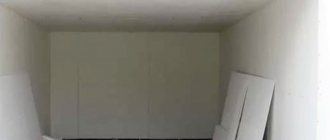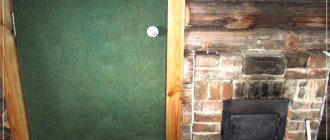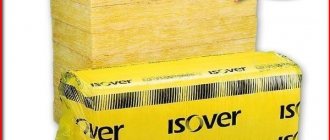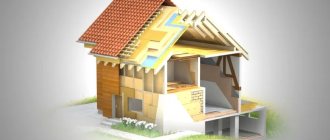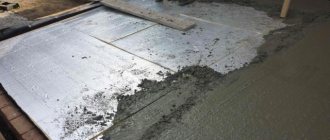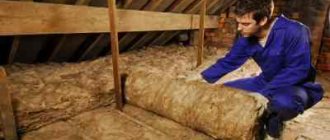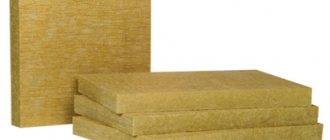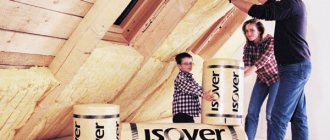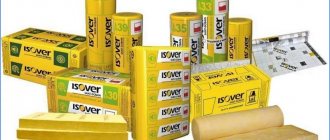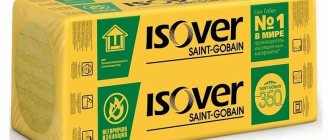One of the leading places on the building materials market belongs to the famous French brand Izover, under whose brand a whole series of insulation materials are produced for the thermal insulation of a house. The product has excellent performance characteristics, which were appreciated by consumers who used it to insulate their home. The material is excellent for internal and external thermal insulation of wooden buildings. Insulating a house with Izover is an excellent way to eliminate heat loss, prevent the entry of cold masses into the room, and increase the comfort of living. In the article we will look at the types and characteristics of heat insulation, and also focus on insulation methods.
Types of insulation materials
The manufacturer produces several product lines, among which there are universal insulation materials that are suitable for thermal insulation of the entire structure. There are also highly specialized materials designed to insulate one or another part of the house: internal and external walls, roofs, floors, baths.
Universal insulation
This group is divided into:
- "Optimal". The material is made of basalt fiber. It is designed for thermal insulation of all parts of a frame house, with the exception of the foundation. They can be used to insulate roofs, partitions, walls, and floors along joists. It has low thermal conductivity, is not flammable, and can be laid without additional fasteners.
- "Pro." The insulation is made of fiberglass mats. Can be used for thermal insulation both inside and outside log houses and frame structures. It has very low thermal conductivity. Safe and non-flammable insulation.
- "Classic". It is also based on fiberglass. It is produced in mats and slabs with a porous structure, due to which it has good thermal insulation characteristics. It is used for various structural elements of a house made of logs and beams, except for surfaces with high loads, including the foundation. It has low strength, so it cannot be used under screed and plaster.
- "Extra". Fiberglass slab insulation is characterized by increased strength and elasticity, resistance to compression. It has the lowest thermal conductivity compared to other materials from the manufacturer, due to which, when used, heat loss is minimal.
- "Warm house". This insulation is made from recycled fiberglass. It is suitable for thermal insulation of any parts of the structure. The material goes on sale in the form of slabs, which are convenient to use for vertical surfaces, and rolled mats used for insulating the floor between joists and interfloor ceilings.
Insulation materials for highly specialized work
Among the materials produced under the Izover brand, it is worth mentioning highly specialized mineral wool insulation materials, which are divided into various groups for individual areas of application:
- Facade insulation. This group of materials is intended for insulating facades under plaster using the wet method. The name of each insulation necessarily contains the word “facade”. They are sold in slabs and are made of basalt or fiberglass.
- Insulation for external and internal walls of a wooden house. This group includes materials that can be used for thermal insulation of suspended structures: under lining, siding, blockhouse and others. All of them are made of glass fiber in the form of slabs, less often in the form of mats.
- Thermal insulators for roofing. Materials for this purpose undergo additional processing to ensure increased moisture resistance. They are made from basalt and glass fibers in the form of slabs and mats.
- Materials for floor insulation. Products in this group are distinguished by increased strength and rigidity; they can withstand increased loads well. They are used for flooring with joists and floating floor structures.
- Insulation for baths and saunas. The main distinguishing characteristic from other groups is a two-layer composition, one layer is mineral wool, the second is a foil coating. The material simultaneously performs two functions - insulation and vapor barrier.
Pros and cons of the material
Despite the fact that each product has its own specifics, it is possible to identify common positive and negative aspects of all Izover brand insulation.
Advantages:
- low thermal conductivity;
- good sound absorption;
- high degree of vapor permeability;
- water resistance;
- non-flammability;
- light weight of slabs.
However, the material also has some disadvantages:
- Formaldehyde resins are used to bind the components, which calls into question the environmental friendliness of the insulation.
- During installation, small particles of material may enter the respiratory tract, so the use of protective equipment is mandatory.
- In direct contact with water, the insulation absorbs moisture, which requires good waterproofing, especially when laying the material on the facade and roof of a log house.
Brand history
The rights to the brand belong to the Saint-Gobain company from France. Its main office is located in Paris, and its founding date is 1665. It appeared at the direction of Louis XIV and produced glass and mirrors. The name Isover insulation is formed from the words “glass” and “insulation”. In our country, the company's products were initially known under the Uteplyaev brand.
Initial Izover products in Russia
Over more than 350 years of history, Saint-Gobain has grown into an international industrial group, represented in 67 countries and employing over 170 thousand employees. Sales in 2015 amounted to 39.6 billion euros. The company is included in the following ratings:
- The hundred largest industrial enterprises according to Forbes.
- Top 100 innovative organizations in the construction sector.
- Best Employer - 2016
Experience and the latest technologies have made the company a world leader in creating a comfortable living space. The main activities of Saint-Gobain are:
- Innovative technologies in the field of high-tech products in the production of ordinary and special glass.
- Building materials represented by ISOVER, ISOTEC, ISOROC brands in insulation; GYPROC in gypsum solutions; WEBER dry mixes; ECOPHON for acoustic ceilings and panels; in siding and tiles - CERTAINTEED; RAM pipes
- Distribution activities in the field of building materials.
Saint Gobain Campaign:
The company's products have been known on the Russian market for more than 20 years. Ten years ago, a plant was opened in the Moscow region (Egoryevsk), and since 2011 in Chelyabinsk, the Minvata company began producing stone fiber insulation. All products have international environmental certificates and comply not only with internal corporate standards, but also EN 13162—ISO 9001.
Thermal insulation of log walls with Izover
- A wooden frame made of beams is mounted on the walls; the distance between the posts should be 10 mm less than the width of the insulation.
- Insulating material is laid in the gaps between the posts. It should fit very tightly, usually no additional fixation is required.
- A vapor barrier membrane is spread horizontally on top of the thermal insulation. The canvases are laid overlapping, and their joints are sealed with adhesive tape.
- A counter-lattice is mounted on the racks to create an air gap, and sheets of drywall, lining or other finishing material are fixed to it.
According to these instructions, walls are insulated both outside and inside a wooden house.
The age-old question - to insulate from the inside or outside
Any external fence separating a living space from the street should be sheathed with thermal insulation on the outside. Accordingly, the insulation of the ceiling on the top floor of a private house is done from the attic side. Causes:
- Installation is physically simplified, which is important when doing the work yourself. There is no need to make a suspended frame or attach insulation from below to the ceiling.
- A layer of insulation 10-20 cm thick (depending on the region of residence) will not reduce the height of the rooms. This is an important plus for old buildings and “Khrushchev” buildings with low ceilings.
- In a lived-in house or apartment, you won’t have to redo the renovations.
- If you do not follow the internal thermal insulation technology, the surface under the insulation will get wet and fungus will appear. Moisture condensation inside the “pie” is promoted by 2 factors: the penetration of water vapor and the formation of a dew point at the junction of dissimilar materials.
When the outer fence is sewn up from the inside, the point of moisture condensation is located near the junction of 2 different building materials
. About the notorious dew point, which is used to scare ordinary homeowners. To avoid condensation inside the structure, it is worth meeting 2 conditions: do not allow water vapor from the room to enter there and use an insulator of sufficient thickness. Then the dew point will be inside the insulation, where there is nothing to condense. The second way is to organize moisture removal using ventilation (read below).
Reference. Dew point is the phenomenon of condensation of water vapor from the air at a certain humidity and temperature. The lower the air temperature, the sooner the degree of extreme saturation with moisture is reached and condensation begins to form.
There are exceptions to the rules; not every room can be insulated from the outside. Examples:
- ceiling of the upper apartment of a multi-story building;
- attic;
- balcony, loggia;
- concrete garage floor above the basement, cellar;
- the need to save money, etc.
For obvious reasons, it will not be possible to insulate a garage basement from above.
In the listed cases, internal thermal insulation of ceilings is arranged with strict adherence to technology. We will describe the work procedure in the form of step-by-step instructions, but first you need to find out...
How to insulate a roof with your own hands
- Wooden posts are installed at a distance of 60 cm from each other.
- A windproof membrane is spread over the frame; it is necessary that it completely covers the inside of the roof and the wooden elements of the sheathing.
- The width of the insulation roll is 1220 mm; cutting it in half produces two strips of 610 mm each.
- The cut parts are installed between the bars; due to their size, they will fit snugly against the racks.
- The entire insulating structure is covered with a vapor barrier film.
- To create a ventilation gap, a counter-lattice is installed, which is then covered with a decorative coating.
Insulation release form
There are also single-layer and two-layer Izover. In the first case, the thickness reaches 5–10 centimeters. The two-layer material does not differ too much in thickness, since here the dimensions of one layer are about 5 centimeters. The slabs can be about a meter in size, or more precisely, this is the standard that can most often be found on the construction market, but there are exceptions when ordering insulation on websites or from dealers.
One roll of Izover insulation is about 16–20 square meters, that is, quite large in size. The roll width reaches 1.2 meters, while its length can vary from 7 to 14 meters. It goes without saying that the technical characteristics will differ slightly depending on the choice of material size.
Recommendations for installing floors under screed
How to insulate a floor along joists with slab material is described in detail in the article “Advantages of Izolon for insulating a wooden floor.” Work with Izover is carried out in a similar way. Here we will describe the main points of wet insulation.
- The concrete base is covered with a waterproof film.
- A special damper tape is installed along the entire perimeter of the room; it should cover part of the floor and the wall, while its height should be 15 cm higher than the level of the screed.
- Insulation boards are laid.
- To protect the material from moisture penetration, another layer of waterproofing is laid on top of the thermal insulation; the sheets should overlap each other by about 20-25 cm.
- The cement screed is poured, after it has completely dried, the excess tape is cut off and the finishing floor covering is laid.
Brand history
The rights to the brand belong to the Saint-Gobain company from France. Its main office is located in Paris, and its founding date is 1665. It appeared at the direction of Louis XIV and produced glass and mirrors. The name Isover insulation is formed from the words “glass” and “insulation”. In our country, the company's products were initially known under the Uteplyaev brand.
Initial Izover products in Russia
Over more than 350 years of history, Saint-Gobain has grown into an international industrial group represented in 67 countries and employing over 170 thousand employees. Sales in 2015 amounted to 39.6 billion euros.
Soundproofing Izover “Quiet House”: The company is included in the following ratings:
- The hundred largest industrial enterprises according to Forbes.
- Top 100 innovative organizations in the construction sector.
- Best Employer - 2016
Experience and the latest technologies have made the company a world leader in creating a comfortable living space. The main activities of Saint-Gobain are:
- Innovative technologies in the field of high-tech products in the production of ordinary and special glass.
- Building materials represented by ISOVER, ISOTEC, ISOROC brands in insulation; GYPROC in gypsum solutions; WEBER dry mixes; ECOPHON for acoustic ceilings and panels; in siding and tiles - CERTAINTEED; RAM pipes
- Distribution activities in the field of building materials.
Saint Gobain Campaign:
The company's products have been known on the Russian market for more than 20 years. Ten years ago, a plant was opened in the Moscow region (Egoryevsk), and since 2011 in Chelyabinsk, the Minvata company began producing stone fiber insulation. All products have international environmental certificates and comply not only with internal corporate standards, but also EN 13162—ISO 9001.
How is thermal protection of a bathhouse performed with Izover
The work is carried out in the following sequence:
- The first stage of work is the installation of frame sheathing, as indicated above.
- Insulation is placed between the vertical posts. The foil side should face outward to provide a reflective effect.
- The heat insulation boards are glued together with adhesive foil tape.
- Additional slats 2.5-3 cm thick are mounted on top of the insulation perpendicular to the posts of the main frame. They will press the insulation more tightly to the wall and also create a gap between the insulation and the decorative cladding.
- The final stage is covering the walls with clapboard, which is attached to the counter-battens.
Finally, about backfilling the attic
The use of bulk materials is the simplest option for insulating the ceiling of a country house, although not the most effective. Thermal insulation is carried out on top of the ceiling in various ways:
- The space between the beams is filled with expanded clay, sawdust or vermiculite crushed stone to the maximum possible height. Flooring boards are laid on top.
- Wood shavings and sawdust are mixed with pre-soaked clay. The space between the joists is filled with the solution.
- A sawdust concrete screed is made - the waste is mixed with cement and sand in a ratio of 5: 1: 1.
If you have a concrete auger mixer at your disposal, you can prepare a more modern insulation for the ceiling - polystyrene concrete. The cement-sand mortar is mixed with polystyrene balls and laid on the ceiling in a layer of 200-300 mm. There is no need to lay the flooring - the monolith has sufficient strength.
Note. There is a mistake in the video - there is no need to place the film under bulk materials. Water vapor (especially in a bathhouse) should freely escape through the expanded clay or sawdust concrete to the outside, and the wood should dry thoroughly.
Stamps
Isover's lines of thermal insulating products include several dozen items and are designed to solve specific problems. They all differ in delivery form, thickness, density and size.
Please note: since all brands have the same base, they are interchangeable.
For general construction work
Izover Profi. A universal material with increased elasticity.
Provides the highest level of thermal protection among the brand's retail materials. Supplied in rolls, plate thickness – 50, 100 and 150 mm. Does not require additional fasteners during installation; can be installed by surprise. Received positive reviews from builders.
Used for insulation and sound protection:
- external walls inside and outside the house;
- pitched roofs;
- interfloor ceilings;
- frame walls;
- internal partitions;
- ventilated facades.
Classic. Supplied in rolls, material thickness – 50 mm.
Can be installed by surprise. Application area:
- insulation of suspended ceilings;
- interfloor ceilings - the material lies between the joists;
- attic spaces.
Isover Classic stove. The shape of mineral wool is slab. Size – 610*1170 mm, thickness 50 and 100 mm. Packaging 5 and 10 m2.
Advantages and disadvantages
Among the advantages of building materials, the following factors are worth noting:
- High-quality thermal insulation. Izover is used in particular for facade insulation, which allows significant savings on heating a house in the winter.
- Resistance to extreme temperatures.
- Fire safety. Mineral wool does not burn, so it is used for insulating multi-story buildings, where the spread of fire would have very serious consequences, as well as for roofs and attic floors, the structure of which consists of wooden elements.
- Resistance to mechanical and chemical influences.
- Tensile strength and no compressive deformation.
- Excellent sound insulation allows the products to be used in plasterboard partitions.
- Resistance to the negative effects of rodents.
- Easy to install.
These technical characteristics of Izover insulation speak in favor of its use in a variety of areas of construction.
However, this material has its drawbacks. During installation, it is necessary to use a full set of personal protective equipment: goggles, gloves, a respirator, long-sleeved clothing that completely covers the body.
Even if it is very hot outside, you cannot neglect the above remedies, because the fibers cause irritation and itching when they come into contact with the skin.
If the insulation is moistened by 1%, its thermal insulation properties deteriorate by 10%. Therefore, when using the material on the roof and attic, it is necessary to carry out waterproofing work, because getting wet will lead to a loss of thermal insulation properties. And when installing slabs on the facade of a building, it must be immediately covered with mesh or plastered to avoid moisture due to precipitation.
Why do you need to insulate your apartment?
Very often, complaints about poor heating come from owners of apartments on the lower floors of panel buildings. The small thickness of the walls does not allow heat to be retained at the proper level. Drafts arise and the walls begin to become damp. As a result, fungus appears on wet surfaces, which is already dangerous to health. Mold not only deteriorates the appearance, it is also impossible to even hang wallpaper over it.
On a note!
Taking into account the fact that utility prices are regularly rising, additional heating sources that consume a lot of electricity are impractical because they are prohibitively expensive.
Insulation of walls from the inside in a private house using mineral wool
Before insulating the walls from the inside, it is necessary to secure the sheathing.
Mineral wool is a material that has good thermal insulation properties, is easy to install and durable.
It is necessary to lay mineral wool slabs between the sheathing boards in such a way that no gaps are formed.
Besides:
- mineral wool is secured with nails and dowels (fungi);
- lay the material from bottom to top;
- The edges of the mineral wool are slightly pressed for a tighter fit.
IMPORTANT!
Mineral wool should be laid in an even layer : without creases and waves; if the installation is multi-layered, the joints should not overlap or form cracks.
After the insulation is securely fastened, a vapor barrier layer is laid on it.
Insulation with mineral wool
